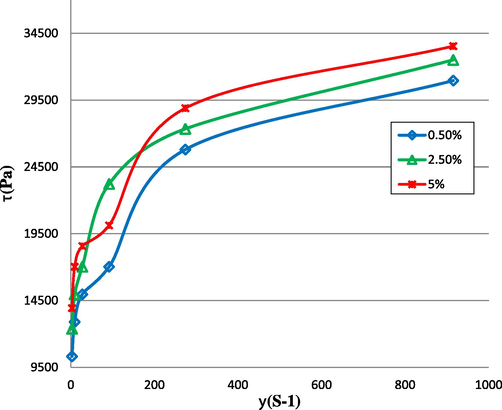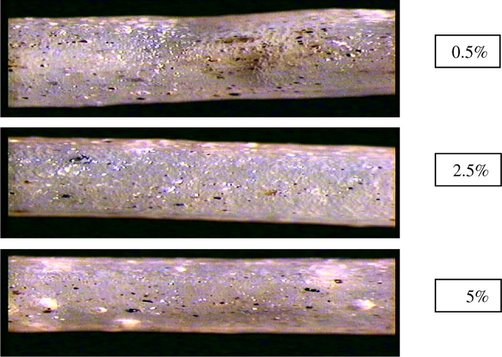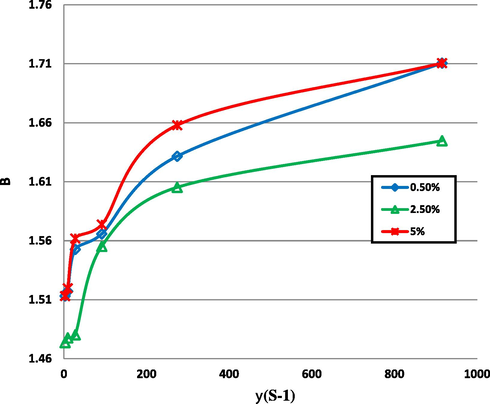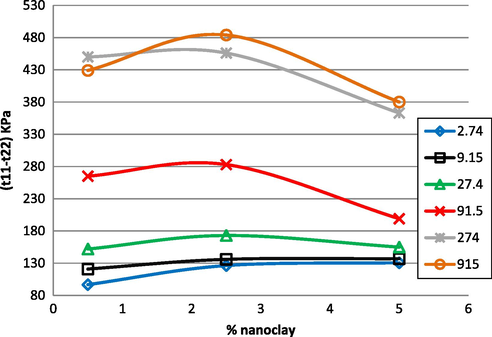Translate this page into:
Control the discontinuity of the flow curve of the polyethylene by nanoclay and compatabilizer
⁎Tel.: +964 7801042860; fax: +964 40417970. moayad_khalaf@yahoo.com (Moayad N. Khalaf)
-
Received: ,
Accepted: ,
This article was originally published by Elsevier and was migrated to Scientific Scholar after the change of Publisher.
Peer review under responsibility of King Saud University.
Abstract
A study on the melt elasticity behavior and extrudate characteristic of low density polyethylene (LDPE)/nanoclay composite and maleated polyethylene (MAPE) as compatabilizer was done. Extrusion studies were carried out in capillary rheometer. A microscope has been used to examine the surface characteristics of the extrudate by taking photographs. With a view to characterize melt elasticity of these nanocomposites, parameters such as die swell, principle normal stress, recoverable shear strain, and shear modulus were calculated. Compatibilizers were premade as block copolymers (BCPs), are of crucial importance during the formation and stabilization of polymer blends. These polymeric surfactants reduce the interfacial tension, R, between the blend components, and due to their ability to accumulate preferentially in the interface, they stabilize the obtained morphology against coalescence. Small amounts of these species in the range of parts of percent are already active.
Keywords
Polyethylene (PE)
Nanoclay
Compatabilizer
Flow curve
1 Introduction
In recent years, the study of polymer/organoclay nanocomposite due to its superior properties compared with neat polymer has attracted major research and commercial interests (Dong et al., 2008; Lertwimolnun and Vergnes, 2005; Toshniwal et al., 2007; Liu et al., 1999; Shih et al., 2008; Wang et al., 2006). The improvement in mechanical properties such as tensile strength and modulus (Toshniwal et al., 2007), solvent resistance (Shih et al., 2008), barrier properties (Wang et al., 2006), and flame retardant capability (Liu et al., 1999), are a few selected examples of the advantages provided by this new class of materials. However, to fully use this improvement, it is necessary to achieve a relatively uniform dispersion of the clay nanoparticles within the polymeric host matrix (Dong et al., 2008; Lertwimolnun and Vergnes, 2005; Toshniwal et al., 2007; Liu et al., 1999; Shih et al., 2008; Wang et al., 2006; Hedayati and Arefazar, 2009).
Polymer composite (PC) offers an easy and cost effective method to develop new materials with desired properties (Saheb and Jog, 1999). The major associated with blending is the immiscibility between the filler and the polymer. The incorporation of various types of filler into polymer matrix was carried out with the aim of improving the specified physical and mechanical properties of polymer composites (Hemelrijck et al., 2005). When polymer melt flows through a capillary under the force of shear, the polymer chains get oriented. As the melt emerges out from the die, the polymer chains tend to recoil, leading to the phenomenon of extrudate swell which causes a contraction in the direction of flow being offset by lateral expansion. This relaxation effect is a result of recovery of the elastic deformation imposed in the capillary. Crosslinking, chain branching, presence of fillers and plasticizers, stress relaxation, etc. are the important factors controlling elastic recovery. The (De/Dc) ratio increase with the die wall shear stress. This effect is due to elastic recovery of the material. Elastic properties and extrudate characteristics of polymer melts in shear flow are of great importance in polymer processing (Moly et al., 2002). In this paper, polymer composite (PC) between low density polyethylene (LDPE) and nanoclay in different percent (0.5%, 2.5% and 2.5%) with 1% maleated polyethylene (MAPE) used as compatabilizer. The shear rate was (2.74, 9.14, 27.4, 91.4, 274 and 914 S−1). The viscoelastic properties of the composite were studied at temperature 190 °C.
2 Experimental
2.1 Materials
The LDPE matrix polymer was commercial pipe grade (Scpilene 22004) from the State Company for Petrochemical Industries (SCPI), Basrah-Iraq with a melt index of 0.3 g/10 min. at 190 °C and 2.16 kg load. The PE-g-MA selected for this work was PB3200, supplied by Crompton, with 2% degree of maleation. Closite 15A, organically modified montmorillonite nanoclay supplied by Southern Clay Products (USA) was used as received.
2.2 Preparation of nanocomposites
Samples were prepared by melt mixing the components. Melt mixing was carried out using a mixer-600 attached to Haake 90 rheometer at a temperature of 140 °C and at a rotor speed of 60 rpm. LDPE was melted for 5 min and blended with nanoclay (0.5%, 2.5% and 5%) for another 5 min. Finally 1% compatibilizer PE-g-MA(MAPE) was added and blended for another 3 min. Digital camera type CCD attached to Photomicroscope (wild) was used for the purpose of photographing the samples.
2.3 Rheological measurements
Rheological properties were carried out by using a capillary rheometer device (Instron model 3211), ASTM D-3835. The diameter of the capillary is 0.76 mm, the length to diameter (L/D) ratio of 80.9, with an angle of entry of 90°. Load weighing which dropped on the polymer melts by plunger transverse from the top to the bottom of the barrel was constant (2000 kg). The constant plunger speeds ranged from 0.06 to 20.0 cm min−1 and the extrusion temperature was 190 °C. The die swell ratio was identified by Eq. (1):
3 Results and discussion
The dependence of the wall shear stress as a function of the apparent shear rate for the LDPE melts that had been filled with various loadings of nanoclay particles is illustrated in Fig. 1. For a given content of nanoclay particles, this property of the melts for (0.5% and 5%) increased sharply for the low shear rate less and then there was concavity at first critical shear stress (τ1) ∼100 S−1 which affected the surface of the polymer composite extrudated and caused sharkskin phenomena as shown in Fig. 2, then the curve was increased non-linearly (Shenoy, 1999). While for the LDPE melt with 2.5% the flow curve was smooth and linear with no discontinuity, this behavior was attributed to the nanoclay particles concentration that achieve a better dispersion between the polymer chains, as a result of this dispersion higher interaction induced between the polymer chains which was stronger that the adhesion forces between the polymer chains and the die surface cylinder wall. The induced chain interactions affected the surface distortion as shown in Fig. 2. Also from Fig. 1, it can be seen that the shear stress has increased in a non-linear, decreasing-rate manner with the increase in the apparent shear rate.
Effect of percent nanoclay and 1% MAPE on the flow curve of LDPE at 190 °C.

Effect of nanoclay concentration on the surface distortion of the LDPE nanoclay composite.
Interestingly, an abrupt increase in the wall shear stress for various samples was observed at an apparent shear rate of ∼270 S−1, after which point the increase in the property value with the apparent shear rate occurred very marginally (Dangtungee and Supaphol, 2008). The increase in the wall shear stress with an increase in the apparent shear rate in a non-linear, decreasing-rate manner indicated that the apparent shear viscosity (i.e., wall shear stress/apparent shear rate) LDPE nanoclay particle-filled melts decreased with an increase in the apparent shear rate (viz. a phenomenon commonly known as shear-thinning) as shown in Table 1 (Supaphol and Harnsiri, 2006).
Share rate
Viscosity (Pa S−1)
0.5%
2.5%
5%
2.74
3766.423358
4519.708029
5084.672
9.15
1409.836066
1635.409836
1860.984
27.4
546.1313869
621.459854
677.9562
91.5
186.0983607
203.0163934
219.9344
274
94.16058394
99.81021898
105.4599
915
33.83606557
35.52786885
36.65574
The dependence of the die swell ratio on the apparent shear rate for the LDPE melts that had been filled with various loadings of nanoclay particles is illustrated in Fig. 3. Here (Dangtungee et al., 2005), the degree of extrudate swell was reported as the die swell ratio (B) .The die swell ratio (B) melts increased in a non-linear manner with an increase in the apparent shear rate for the LDPE contain (0.5% and 5%) nanoclay particle and there was nonlinearity at the first critical shear rate. From Fig. 3, the effect of the nanoclay particle concentration on the die swell was clear. The LDPE with 2.5% nanoclay particle has the less die swell value with all shear rate value, which was normal behavior of the filled polymer with less deformation will have reduce melt elasticity (Tsai and Lin, 2010).
Variation of die swell ratio of polymer composite with shear rate at 190 °C.
Melt elasticity parameter first normal stress difference (t11–t22) of the composites was evaluated at 190 °C. Variations of the (t11–t22) vs. percent of nanoclay particle for the LDPE composite are presented in Fig. 4. It appears that the first normal stress difference increased with increased shear rate. This is quite expected because on emergence from the die the stored elastic energy is released causing the polymer swell (Gupta et al., 2003). At higher shear rates the extent of elastic energy stored and subsequently released will be greater.
Variations of the (t11–t22) vs. percent of nanoclay particle for the LDPE composite.
4 Conclusion
The flow and elastic properties of the nanocomposite was evaluated to determine the effective concentration of nanoclay. The following conclusions can be drawn from the conducted study:
-
Control the discontinuity of the flow curve of the polyethylene in the presence of MAPE as compatabilizer with 2.5% of nanoclay.
-
The extrudate swell was increased non-linearly with increasing shear rate with the 2.5% nanoclay concentration in the composite that has the less die swell value.
-
The extrudate surface distortion was eliminated by the 2.5% nanoclay.
-
The melt elasticity which was characterized here by the first normal stress difference increased with increased shear rate because the stored elastic energy is released causing the polymer swell.
References
- Melt rheology and extrudate swell of titanium (IV) oxide nanoparticle-filled isotactic polypropylene: effects of content and surface characteristics. Poly. Test.. 2008;27(8):951-956.
- [Google Scholar]
- Melt rheology and extrudate swell of calcium carbonate nanoparticle-filled isotactic polypropylene. Poly. Test.. 2005;24(1):2-11.
- [Google Scholar]
- Experimental characterisation and object-oriented finite element modelling of polypropylene/organoclay nanocomposites. Compos. Sci. Technol.. 2008;68:2864-2875.
- [Google Scholar]
- Melt rheological properties of polypropylene/lldpe copolymer blends. Poly.-Plast. Technol. Eng.. 2003;42(3):357-372.
- [Google Scholar]
- Multi-scale analysis of polypropylene based organoclay containing composites, Part 1: Morphology. Poly. Test.. 2009;28(2):128-138.
- [Google Scholar]
- The effect of block copolymer architecture on the coalescence and interfacial elasticity in compatibilized polymer blends. J. Rheol.. 2005;49(3):783-798.
- [Google Scholar]
- Influence of compatibilizer and processing conditions on the dispersion of nanoclay in a polypropylene matrix. Poly. 2005;46(10):3462-3471.
- [Google Scholar]
- Studies on nylon 6/clay nanocomposites by melt-intercalation process. J. App. Poly. Sci.. 1999;71(7):1133-1138.
- [Google Scholar]
- Melt elasticity behaviour and extrudate characteristics of LLDPE/EVA blends: effect of blend ratio, compatibilisation and dynamic cross-linking. Mat. Lett.. 2002;53(4–5):346-352.
- [Google Scholar]
- Rheology of filled polymer system. Kluwer Academic Publishers; 1999.
- Preparation and properties of biodegradable PBS/multi-walled carbon nanotube nanocomposites. Poly. 2008;49(21):4602-4611.
- [Google Scholar]
- Rheological and isothermal crystallization characteristics of neat and calcium carbonate-filled syndiotactic polypropylene. J. App. Poly. Sci.. 2006;100(6):4515-4525.
- [Google Scholar]
- Dyeable polypropylene fibers via nanotechnology. J. App. Poly. Sci.. 2007;106(1):706-711.
- [Google Scholar]
- Study on the die swell influence of nano-titanium dioxide on the PP/PT-PVA blend melt. Poly.-Plast. Technol. Eng.. 2010;49:1030-1035.
- [Google Scholar]
- The role of clay network on macromolecular chain mobility and relaxation in isotactic polypropylene/organoclay nanocomposites. Poly. 2006;47(20):7131-7144.
- [Google Scholar]







